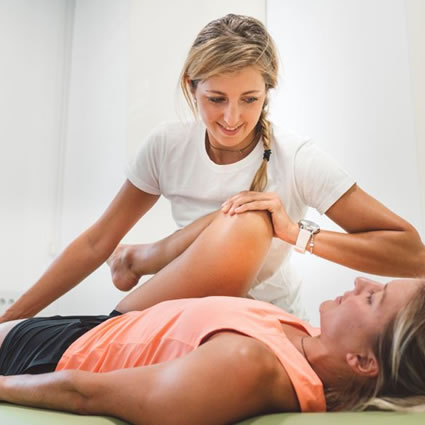blog | inmotion training studio

Assisted Stretching- What is it and how can it benefit me? - Copy
I have been a little reluctant to jump on the bandwagon of assisted stretching as a singular service. I have always done some sort of "stretching/Flexibility/mobility" training with clients and have taught a mobility class for over 4 years which has helped my flexibility and injuries tremendously. I recently went to a session at Stretch Lab as i have had a few clients inquire about it and I don't recommend anything unless I have tried it myself... so my husband (which does not stretch enough or at all unless in the hot tub) went and tried a 25 minute session...
I will admit it was better than I expected.. Although I do a lot of mobility, flexibility, yoga, stretching, dynamic warm-ups and all of it has helped me- there is something to be said about someone else doing the work while you breathe and basically relax while they do the work. There were a few positions I couldn't do on my own and a lot we do in our mobility sessions like PNF stretching with a band. I didn't get any upper body stretches because it was only 25 minutes and although I liked it I would rather pay for a massage for my needs.
I felt the session pricing is a little expensive for going to a "flexoligist" that I have way more experience in such as foam rolling, self myofascial release, Reflexive performance reset (RPR), Yoga Trapeze, Yoga Shred, Mobility & Flexibility Training and are charging more than I do with all of my experience and for personal training.
That being said- my husband really enjoyed it and has had back and tight hamstrings so has become my guinea pig and a big reason why I decided to get certified to add to client experience and to my background so I can provide clients with this service in a one stop shop. So let's find out what it is and what the benefits are.....
So what the heck is it and why should I try it out?
Assisted stretch therapy is a type of recovery service that involves the use of a therapist to help you stretch your muscles. It can be used to improve flexibility, reduce soreness and improve range of motion. Assisted stretch therapy can be used to assist with a variety of conditions, including back stiffness, neck stiffness, shoulder stiffness, and more. It is also used as part of an overall fitness program to help improve overall recovery.
Benefits of Assisted Stretch Therapy
Assisted stretch therapy has many benefits for both athletes and non-athletes alike. It can help improve flexibility and range of motion in the joints and muscles, reduce soreness associated with acute or chronic conditions, improve posture, and even reduce stress levels. Additionally, assisted stretch therapy can help performance via the body's ability to move through its full range of motion without strain or discomfort. This can be especially beneficial for athletes who need to perform at their best in order to stay competitive.
The Benefits of Assisted Stretch Therapy for Older Adults
Age plays a factor in the loss of strength and mobility in our tissues. The key to making sure your muscles and joints don't lose range of motion is to maintain physical activity. Doing so as we age reduces the chance of injury and maintains mobility. Incorporating at-home stretching and assisted stretch therapy into your lifestyle can ensure you reach your goals and may even increase your lifespan! It is important to be regular with stretching to maximize long-term benefits.
Relieves Pain and Arthritis
Do stiff hips, cracking knees, sore back, or achy joints sound familiar? Stretching can relieve symptoms associated with arthritis by lubricating the joints and enhancing and maintaining healthy range of motion. Additionally, stretching activates the parasympathetic nervous system which will cause an endorphin release, reducing the intensity of pain while also reducing acute inflammation. It's important to take joints through their full range of motion on a daily basis.
Improves Poor Posture
Due to careers spent chronically sitting/standing, lifestyle choices, injuries, and genetics, posture is affected later in life. Signs will show such as a rounded back, forward head, back pain, and joint pain. There is hope! Posture can be modified with regular stretch therapy and a tailored at-home program that addresses your body's specific postural patterns. Here at The Anatomy of Wellness, we provide tailored stretch therapy sessions that are personalized based on a movement and postural assessment. We differ from other businesses that offer stretch therapy because of this customized approach to your care.
Increases Blood Flow and Energy Levels
Consistent stretching, done the right way, can improve circulation. This in turn gets oxygen and nutrients to the soft tissues of the body reducing recovery and healing times. A stretch session will get your muscles warm in preparation for the low-intensity PNF stretches which are gentle yet effective.
Stretching is an essential part of muscle re-education. Muscle re-education comes into play when we relearn faulty movement patters that lead to pain and preventable injuries. In addition to motor control and targeted strengthening exercises, stretching must be employed in order to reinforce the new pattern.
Our assisted stretch therapy sessions stand apart from others because we use assessment to drive our treatment. We do not offer cookie-cutter sessions that are arbitrarily given to clients. Rather, our mobility specialist will start by assessing your unique mobility restrictions and movement patterns. One of the go-to assessments we use is an overhead squat. The overhead squat brings to light gross compensation patterns clogging up your joints and muscles and preventing you from moving freely.
Reduces the Risk of Falling
For those in the aging population, please take mobility seriously! The risk of falling and avoidable injury shoots up as we age. So much of it can be prevented with stretching and consistent physical activity. Motion is lotion, as the saying goes and if you don't use it, you will lose it (mobility). Motor control and balance is also crucial in avoiding injury related to age, and we can help with that too!
More Benefits
Other benefits of assisted stretch therapy include perks like better sleep, a reduction in stress hormones, reduced muscle tension and pain, and an overall improved mood! When you visit us, we provide you with customized at-home stretches for you to perform between sessions to optimize your treatment plan.
How Does Assisted Stretch Therapy Work?
Assisted stretching works by using a therapist or other trained professional to guide you through stretches that target specific areas of the body. The therapist will use their hands and other tools such as foam rollers or massage guns to apply pressure and provide assistance as you move through each stretch. This helps ensure that you are performing the stretches correctly and safely while also providing additional support if needed.

The Science Behind Assisted Stretching: Types & Modalities used
Practitioner assisted stretching leverages the body's natural reflexes and biomechanics to enhance flexibility, mobility, and overall muscle function. Here’s a closer look at the science behind it:
1. Stretch Reflex
The stretch reflex, or myotatic reflex, is an involuntary contraction of a muscle in response to stretching within the muscle. This reflex is mediated by muscle spindles, which are sensory receptors within the muscle. When a muscle is stretched too quickly or too far, these spindles send a signal to the spinal cord, which then sends a signal back to the muscle to contract. This is a protective mechanism designed to prevent muscle tears. During practitioner assisted stretching, the practitioner carefully controls the intensity and speed of the stretch to manage the stretch reflex, allowing the muscle to relax and stretch more deeply over time.
2. Golgi Tendon Organ (GTO) Activation
The Golgi tendon organs are sensory receptors located in the tendons near the muscle-tendon junction. They respond to changes in muscle tension. When the tension in the muscle increases, the GTOs send a signal to the spinal cord, which then sends a signal to the muscle to relax. This is known as autogenic inhibition. By applying a steady, gentle pressure, a practitioner can activate the GTOs, which helps the muscle to relax and lengthen, allowing for a deeper and more effective stretch.
3. Reciprocal Inhibition
Reciprocal inhibition is a process where the contraction of one muscle (the agonist) causes the relaxation of the opposing muscle (the antagonist). Practitioners use this principle by contracting the muscles opposite to the ones being stretched. This helps the targeted muscle relax and stretch further. For example, contracting the quadriceps helps the hamstrings relax during a hamstring stretch.
4. Proprioceptive Neuromuscular Facilitation (PNF)
PNF is a stretching technique that involves both the stretching and contracting of the muscle group being targeted. This technique takes advantage of the natural responses of the nervous system to enhance muscle elasticity and flexibility. PNF typically includes a passive stretch followed by an isometric contraction of the muscle being stretched, and then another passive stretch. The contraction activates the GTOs, which enhances muscle relaxation during the subsequent stretch.
5. Improved Blood Flow and Oxygenation
Stretching, especially when assisted by a practitioner, can improve blood circulation to the muscles. Enhanced blood flow brings more oxygen and nutrients to the muscles, which aids in recovery, reduces muscle soreness, and improves overall muscle function. This increased circulation also helps remove metabolic waste products like lactic acid from the muscles.
6. Fascial Release
The fascia is a connective tissue that surrounds muscles, bones, and joints. It can become tight and restrictive due to inactivity, injury, or repetitive movements. Practitioner assisted stretching can help release tension in the fascia, improving overall flexibility and movement efficiency. Techniques such as myofascial release are often incorporated into assisted stretching sessions to target these connective tissues.
7. Neuromuscular Re-education
Practitioner assisted stretching can help retrain the nervous system to allow for greater flexibility and range of motion. By consistently stretching and holding positions with the help of a practitioner, the nervous system becomes accustomed to these new ranges of motion, reducing the likelihood of muscle tightness and increasing overall mobility.
The science behind practitioner assisted stretching involves a complex interplay of neuromuscular reflexes, sensory receptors, and biomechanical principles. By understanding and leveraging these mechanisms, practitioners can help individuals achieve deeper, more effective stretches that improve flexibility, reduce muscle tension, and enhance overall physical performance.
What Does Assisted Stretching Offer?
Controlled Environment
A practitioner assisted stretch is performed in a controlled environment, such as a studio or clinic, with equipment specifically designed for this type of activity. This minimizes the risk of injury and provides a safe space for the individual to stretch.
Customization
A practitioner assisted stretch can be customized to the individual’s needs and limitations. A trained practitioner can adjust the intensity and duration of the stretches based on the individual’s age, fitness level, health status, and specific goals.
Professional Guidance
Assisted stretching should be performed by a trained and certified practitioner who has a thorough understanding of anatomy and physiology. This ensures that the stretches are performed safely and effectively.
Monitoring
During a practitioner assisted stretch session, the practitioner can monitor the individual’s range of motion and adjust the stretches as needed. This helps to prevent overstretching and injury.
Adaptable to Different Abilities
Stretching can be adapted to different abilities and limitations. For example, individuals with limited mobility can benefit from practitioner assisted stretching by focusing on gentle stretches and movements.
Benefits of Assisted Stretching for Physical Health
Practitioner assisted stretching can offer a range of benefits for physical health. For example, it can help reduce muscle tension and soreness, which can be especially beneficial for athletes or people who engage in regular physical activity. By improving posture and alignment, practitioner assisted stretching can also help reduce the risk of injury and enhance performance.
With that in mind, here are some of the physical benefits of practitioner assisted stretching:
Improved Balance
As we age, our balance and stability can decline, increasing the risk of falls and injuries. Regular stretching can help improve balance by strengthening the muscles and joints that support our bodies. This can be particularly beneficial for older adults who may have decreased mobility or balance issues. Improved balance can also enhance performance in sports and other physical activities.
Enhanced Joint Health
Joints are the connections between bones that allow for movement. Regular stretching can help keep your joints healthy by improving their range of motion and flexibility, reducing the risk of stiffness, and preventing injuries. This can be helpful for people with arthritis, who may experience joint discomfort and inflammation.
Improved Muscle Tone
Stretching can help improve muscle tone by increasing blood flow to the muscles and promoting the development of lean muscle mass. This can lead to greater strength and improved definition in the muscles. Stretching also helps
Are you ready to try it out? Stay tuned for specials starting mid August and if you are a current personal training client- I'll start adding it here and there to some of your sessions so you can try it out!
In motion training studio - bend
social media
REQUEST MORE INFORMATION
change you can do & results you will see

inMotion Training Studio
1279 NE 2nd St, Bend, Oregon 97701
541-241-6989
inmotionbend@gmail.comFollow Us
FOLLOW US
YouTube
COPYRIGHT © 2023 - PRIVACY POLICY / WEB PURCHASES REFUND POLICY





